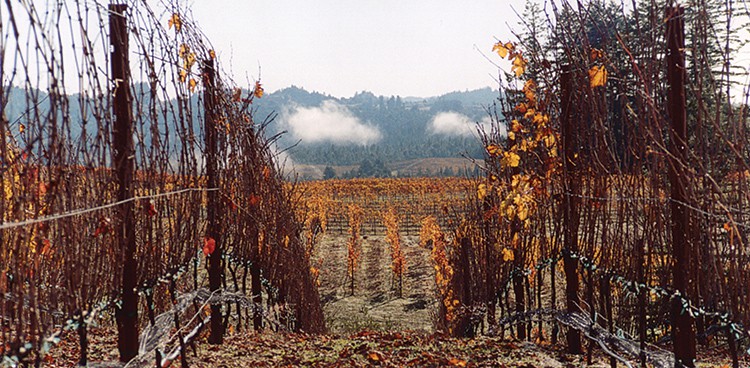
Syrah is the red equivalent of Riesling when it comes to buying wine: the wine everyone talks about but nobody drinks, the one sommeliers wish guests would order instead of the more usual suspects. And that’s too bad, because syrah is where it’s at in California right now.
Sure, there are plenty of California syrahs that aim to be nothing more than cheap and easy, in the mode of the Aussie “good drinks” that spurred them on. And there are other syrahs that wish to be in the Cult Cab crowd, thick and black with fruit, and glossed with the vanilla sheen of oak.
Both styles have their place, but there’s another that’s emerging as of late: syrah that’s cool and lean, heavy on the herbs and lighter than usual on the fruit, shot through with an acidity that makes them feel frisky. With their power in sinew rather than size, they are excellent table companions, versatile and mouthwatering.
Not that these wines are easy to find yet. It was a colleague of mine, Patrick Comiskey, who brought them to my attention. Although he lives on the West Coast, his tastes run in an eastern direction, more toward Côte Rôtie than Dry Creek Valley. So when he proclaimed, “The wild is back,” in an article about California syrah on Zester Daily back in October 2009, I paid attention.
By “wild,” he was referring to characteristics more often assigned to syrah grown in cooler places, like France’s Rhône Valley, the Holy Grail for syrah lovers worldwide: black pepper, violets, herbs, underbrush, and smoke. And in fact, the wines he was talking about came from corners of California formerly written off as too cold to ripen the grape (or even a cool-loving variety like pinot noir, for that matter): the outer edges of the Sonoma Coast, for example, or the cool, foggy banks of the Petaluma Gap, or patches of Monterey County. Such extreme wine growing sometimes yielded extreme results: “Dipping your nose in some of these wines is like walking into a room-sized peppermill,” Comiskey wrote.
I don’t know about you, but that sounds compelling to me. So while I wait for Comiskey to finish the book he’s writing on the evolution of syrah in California, I’ve been searching the state’s cooler pockets for whatever examples I can get my hands on. When I do find some, I like to open up two or three bottles at once so I can compare and contrast over the course of an evening; unlike their bigger, richer compatriots, they often take time to show themselves, and have more details to notice as they open. Plus, at alcohol levels closer to 13 percent rather than 15, it’s easier to drink more than one glass.
Nevertheless, it leaves me with a lot of red wine left over at the end of dinner. Which brings me to the other lesson I’ve learned in the process of studying California syrah: all this bashing of red wine with cheese? Get over it, people. Yes, white wines will always be the safer bet; they are gentler and quieter, allowing more cheeses to shine; they have less alcohol and no tannin to go metallic against the cheese. But when there’s a bit of red left in the bottle after the main course has been cleared away, there’s no reason to feel uncouth when you reach for the cheese—particularly when the red in question is cool and vibrant, not heavy or torridly alcoholic. The 2008 Wind Gap Wines Syrah feels almost like a white, its red fruit gauzy with a cool acidity; it’s delicate enough to yield to the creamy flavors of Jasper Hill Farm’s bloomy rind, Moses Sleeper. A frisky Bonny Doon Vineyard Syrah from Santa Cruz manages to both meld its peppery, herbal flavors into the grassy notes of Twig Farm’s Square Cheese and also counter the funk of the cheese’s thick, crumbly rind.
Those are special examples; not every cool-climate syrah deals so gracefully with a bloomy or funky rind (watch for tannins!). But they also show just how far these syrahs are from the rich, soft, jammy syrahs more commonly regarded as California-style. And I’ve yet to find a peppery, herbal, violet-scented syrah that didn’t fare well with a chunk of something milky, firm, and smooth—Vella Cheese Company’s Mezzo Secco, if you can get it, an Abbaye de Belloc, or an alpine-style cheese. So start cracking open bottles, and pull out the cheese while you’re at it: it’s time to stop talking about syrah and start drinking it.
CALIFORNIA
Mendocino County:
Copain 2009 Tous Ensemble Syrah ($23)
Mendocino Ridge:
Drew Family Cellars 2008 Valenti Vineyard Syrah ($36)
Outer Sonoma Coast:
Peay Vineyards 2006 La Bruma Syrah ($51)
San Luis Obispo County:
Bonny Doon Vineyard 2007 Alamo Creek Syrah ($35)
Santa Maria Valley:
Nielson Vineyard 2007 Qupé Syrah ($35)
Sonoma Coast:
Wind Gap Wines 2008 Sonoma Coast Syrah ($34)
Feature Photo Credit: Peay Vineyards | Wine Glass: Shutterstock





